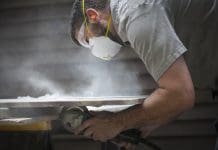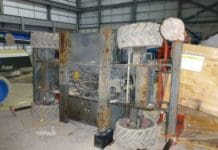Two parties responsible for the deaths of two employees have been handed punishments by the courts for health and safety negligence
A man has been jailed after failing to administer work at height regulations, causing a worker to fall to his death at a commercial property in north London.
Patrick McCarthy, trading as All Care Home Improvements, was given a 14-month custodial sentence after Mr Andrei-Ionel Hutanu died from his injuries in 2019, a week after the fall. No scaffolding or other safety measures had been put in place to prevent potential falling.
The jury at Harrow Crown Court heard how 33-year-old Mr Hutanu and another man were working on a commercial property in Neasden on 19 August 2019. Mr Hutanu’s co-worker was instructed to remove building materials from a flat roof, while Mr Hutanu was told to carry out repair work on a tiled roof. Mr Hutanu was working from a roofing ladder when he fell approximately 16 feet onto the concrete alleyway below.
Mr Hutanu sustained a fracture to his neck and other serious head injuries. Despite being airlifted to St Mary’s Hospital in Paddington, he died a week later, on 26 August 2019.
What does the law state about work at height regulations?
The Work at Height Regulations 2005 states that ‘every employer, in selecting work equipment for use in work at height, shall give collective protection measures priority over personal protection measures; and take account of the working conditions and the risks to the safety of persons at the place where the work equipment is to be used’.
An investigation by the Health and Safety Executive (HSE) into the incident found that 37-year-old McCarthy had failed to install the appropriate measures to prevent falls from height after failing to assemble scaffolding around the perimeter of the building or flat roof where the men had been working.
According to the HSE, employers should do the following to ensure safety when working from a height.
- do as much work as possible from the ground;
- ensure workers can get safely to and from where they work at height;
- ensure equipment is suitable, stable and strong enough for the job, maintained and checked regularly;
- make sure you don’t overload or overreach when working at height;
- take precautions when working on or near fragile surfaces;
- provide protection from falling objects;
- consider your emergency evacuation and rescue procedures.
McCarthy of Pasture Road, London, pleaded guilty to breaching Regulation 6(3) of the Work at Height Regulations 2005. McCarthy was given a 14-month custodial sentence at a hearing on 4 April 2023.
The incident could have been avoided, according to the court
“This tragic incident could have been easily avoided. Assessing and planning work at height is essential to ensuring that suitable and sufficient measures are in place to prevent falls from height,” said HSE inspector Philip Jordan after the hearing.
“The custodial sentence imposed on Mr McCarthy should underline to everyone in the construction industry that the courts, and HSE, take health and safety negligence extremely seriously. HSE will not hesitate to take appropriate enforcement action against individuals or companies that fall below the required standards,” concluded Jordan.
Worker dies after health and safety negligence on Nottingham construction site
Following a similar incident of health and safety negligence, a concrete manufacturer has been fined £1m after a 24-year-old man died from a head injury in Nottingham. Stewart Ramsey, from Mansfield, was working for Creagh Concrete Products Ltd (CCP) at its Thurgarton Lane site in Hoveringham when he died on 15 March 2017.
Mr Ramsey was using a metal grab, which should not have been in use, to unload Spantherm, a concrete building product, from a trailer. Mr Ramsay’s head became trapped in the metal graph after a rope connected to the locking leaver broke. Despite the rope being tied in a double-knot, the lock mechanism released the jaws of the grab as Mr Ramsey pulled on it.
After admitting to health and safety negligence towards their employees while carrying out lifting operations, CCP was sentenced at Nottinghamshire Crown Court on 5 April. An investigation by the HSE found that CCP did not have an appropriate system of work for the use of the grab. The HSE also found that CCP had not completed a risk assessment to identify the risks of using a metal grab.
The grab and the forklift in use were found to be in poor condition, and neither should have been in service at the time of the incident. According to the investigation, CCP had failed to ensure that the equipment was in efficient working order or good repair.
Creagh Concrete Products Limited of Hoveringham, Nottinghamshire, pleaded guilty to breaching Section 2(1) of the Health and Safety at Work etc. Act 1974 in that it failed to ensure, so far as was reasonably practicable, the health, safety, and welfare at work of all its employees. CCP was fined £1,000,000 and ordered to pay costs of £47,521.08.
“Stewart’s death could easily have been prevented if his employer had acted to identify and manage the risks involved and to put a safe system of work in place,” commented HSE inspector Mr Amandip Dhanda.
“The work equipment being used at the time of the incident should not have been in use, and the employer would have known this had they effectively followed their own health and safety systems,” concluded Mr Dhanda.














